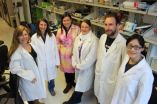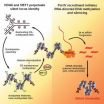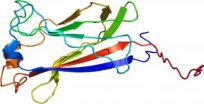(Press-News.org) Neuroimages play a growing role in biomedical research, medicine, and courtrooms, as well as in shaping our understanding of what it means to be human. But how helpful are they at answering complex questions such as: What is depression? Is a defendant lying? Do we have free will?
These are among the topics explored in Interpreting Neuroimages: An Introduction to the Technology and Its Limits, a special report of the Hastings Center Report. It is edited by Josephine Johnston, a research scholar and director of research, and Erik Parens, a senior research scholar, and it includes commentaries by leaders in neuroscience and its ethical implications. The report is the product of a project funded by The Dana Foundation.
Neuroimaging technologies capture information about the brain as a person thinks, feels, and experiences sensations. They will be indispensable to the BRAIN (Brain Research through Advancing Innovative Neurotechnologies) initiative launched by the federal government this year to advance understanding of the human brain and brain disorders.
The special report consists of six essays:
Neuroimaging: Beginning to Appreciate Its Complexities
Erik Parens and Josephine Johnston
While neuroimages are being used in courtrooms to help determine both guilt and sentencing, in marketing, and in the diagnosis of mental disorders, they are "readily open to misinterpretation, overinterpretation, and misapplication," write Parens and Johnston. They advise scientists, clinicians, lawyers, and others to be clear about how neuroimages are made and what they can—and cannot—do.
Functional Neuroimaging: Technical, Logical, and Social Perspectives
Geoffrey K. Aguirre
With new, powerful analytic techniques, there has been a shift in goals, from trying to understand the neural basis of a particular emotional or mental state to trying to predict behavior. But there are limits to the information that neuroimaging can convey. Aguirre explains the many steps involved in transforming raw data into a finished brain image.
Brain Images, Babies, and Bath Water: Critiquing Critiques of Functional Neuroimaging
Martha J. Farah
Neuroimages have attracted a lot of criticism, such as that they do not show neural activity directly and that they are "too convincing." Farah takes on the criticisms and finds that in some cases they have been overextended in ways that are inaccurate or misleading. "None of the criticisms reviewed here constitute reasons to reject or even drastically curtail the use of neuroimaging," she concludes.
Neuroimaging and Psychiatry: The Long Road from Bench to Bedside
Helen S. Mayberg
Neuroimaging has implications for psychiatric diagnosis, treatment, and risk assessment, but it is not ready for use in clinical psychiatry. Claims to the contrary "give false hope to patients and their families," writes Mayberg, who reached this conclusion after spending the last 20 years studying functional neuroimaging patterns in patients with depression.
Seeing Responsibility: Can Neuroimaging Teach Us Anything about Moral and Legal Responsibility?
David Wasserman and Josephine Johnston
Neuroimages that visualize a decision-making activity or its timing could alter our understanding of personal responsibility by challenging the notion of free will. Although neuroscience may point toward determinism, Wasserman and Johnston argue that the concepts of moral and legal responsi¬bility are likely to be modulated rather than discarded.
Living with the Ancient Puzzle
Erik Parens
Neuroimaging can help explain how experiences arise in human beings but Parens thinks that it cannot by itself let us understand what it means to be a human being.
In addition to Johnston and Parens, contributors are Geoffrey K. Aguirre, associate professor of neurology at the University of Pennsylvania and associate director of the Center for Neuroscience and Society; Martha J. Farah, director of the Center for Neuroscience and Society and the Walter H. Annenberg Professor in the Natural Sciences at the University of Pennsylvania; Helen S. Mayberg, professor of psychiatry, neurology, and radiology and the Dorothy Fuqua Chair in Psychiatry Imaging and Therapeutics at Emory University School of Medicine; and David Wasserman, a visiting scholar in the Department of Bioethics at the National Institutes of Health.
INFORMATION:
Interpreting neuroimages: The technology and its limits
As brain images become increasingly important in research, medicine, and law, a Hastings Center special report examines what they can -- and cannot -- tell us about ourselves
2014-03-20
ELSE PRESS RELEASES FROM THIS DATE:
Proteins that control energy use necessary to form stem cells
2014-03-20
Proteins that regulate energy metabolism are essential for stem cell formation, University of Washington researchers find.
Two proteins that control how cells metabolize glucose play a key role in the formation of human stem cells, UW researchers report.
The findings advance scientists' understanding of stem cell development but also suggest that the proteins, which also play a role in the process that transforms normal cells into cancer stem cells, might also be targets for new cancer therapies, the researchers write.
The findings appear online in the journal Cell ...
Gene silencing instructions acquired through 'molecular memory' tags on chromatin
2014-03-20
BLOOMINGTON, Ind. -- Scientists at Indiana University have unlocked one of the mysteries of modern genetics: how acquired traits can be passed between generations in a process called epigenetic inheritance. The new work finds that cells don't know to silence some genes based on information hardwired into their DNA sequences, but recognize heritable chemical marks that are added to the genes. These chemical tags serve as a form of molecular memory, allowing cells to recognize the genes and remember to silence them again in each new generation.
The discovery made by a 12-member ...
Study reveals a major mechanism driving kidney cancer progression
2014-03-20
The shortage of oxygen, or hypoxia, created when rapidly multiplying kidney cancer cells outgrow their local blood supply can accelerate tumor growth by causing a nuclear protein called SPOP—which normally suppresses tumor growth—to move out of the nucleus to the cytoplasm, where it has the opposite effect, promoting rapid proliferation.
In the March 20, 2014, issue of the journal Cancer Cell, researchers from Chicago and Beijing describe the mechanisms that enable hypoxia to cause the overexpression of SPOP. They show that hypoxia also stimulates the shuttling of SPOP ...
Passive acoustic monitoring reveals clues to minke whale calling behavior and movements
2014-03-20
Scientists using passive acoustic monitoring to track minke whales in the Northwest Atlantic have found clues in the individual calling behaviors and movements of this species. These findings, recently published online in the journal Behaviour, provide insight into one of the least studied baleen whales.
"Although we regularly observe minke whales in our Gulf of Maine surveys, we know very little about minke whale vocalizations and how they use sound in their behavioral and social interactions," said Denise Risch, lead author of the study and a marine mammal researcher ...
Size, personality matter in how Kalahari social spiders perform tasks
2014-03-20
At first glance, colonies of thousands of social spiders all look the same and are busy with the same tasks. Not so, says researchers Carl Keiser and Devin Jones of the University of Pittsburgh in the US, after carefully studying various gatherings of Stegodyphus dumicola social spiders of the Kalahari Desert in South Africa. The size and condition of a particular spider's body indicates which task it generally performs within a colony. In addition, neighboring colonies can have different "personalities" too, writes Keiser, lead author of a study published in Springer's ...
Swing voters hold more sway over candidates on economic issues
2014-03-20
CHAMPAIGN, Ill. — New research from two University of Illinois economics professors who study election trends analyzes how polarization on social issues affects competing candidates' economic platforms.
In the paper, co-authors Stefan Krasa and Mattias Polborn develop a theory of candidate competition that accounts for the influence of both economic and cultural issues on individual voting behavior.
"Many pundits and academics have argued that political polarization, particularly on social and cultural issues, has increased in the U.S.," said Polborn, also a professor ...
UTMB researchers discover a way to potentially slow down Alzheimer's
2014-03-20
Researchers at the University of Texas Medical Branch at Galveston have discovered a way to potentially halt the progression of dementia caused by accumulation of a protein known as tau.
Normally, tau protein is involved in microtubule formation, which acts as a brain cell's transportation system for carrying nutrients in and waste out. In the absence of tau protein, brain cells become dysfunctional and eventually die.
In many forms of dementia, such as Alzheimer's disease and chronic traumatic encephalopathy caused by multiple concussions, the tau protein starts behaving ...
What singing fruit flies can tell us about quick decisions
2014-03-20
You wouldn't hear the mating song of the male fruit fly as you reached for the infested bananas in your kitchen. Yet, the neural activity behind the insect's amorous call could help scientists understand how you made the quick decision to pull your hand back from the tiny swarm.
Male fruit flies base the pitch and tempo of their mating song on the movement and behavior of their desired female, Princeton University researchers have discovered. In the animal kingdom, lusty warblers such as birds typically have a mating song with a stereotyped pattern. A fruit fly's song, ...
As age-friendly technologies emerge, experts recommend policy changes
2014-03-20
From smart phones to smart cars, both public and private entities must consider the needs of older adults in order to help them optimize the use of new technologies, according to the latest issue of Public Policy & Aging Report (PP&AR), titled "Aging and Technology: The Promise and the Paradox." A total of eight articles all from authors affiliated with the Massachusetts Institute of Technology AgeLab are featured.
"Remarkable technological advances are all around us, and leaders in the business and scientific communities are keenly aware of 'the aging of America' and ...
A braking system for immune responses
2014-03-20
The surface of immune system cells is home to a number of receptors which are able to detect pathogens. As soon as these receptors are activated, inflammation occurs and the body's defense mechanisms kick in. Immune cells also have receptors that regulate or even suppress immunological responses to prevent damage to individual cells.
There are other immune receptors that recognize endogenous substances that are released when tissue damage or cell death occurs. As such, the organism can defend itself even in cases where the damage caused by the pathogen, but not the pathogen ...
LAST 30 PRESS RELEASES:
Making lighter work of calculating fluid and heat flow
Normalizing blood sugar can halve heart attack risk
Lowering blood sugar cuts heart attack risk in people with prediabetes
Study links genetic variants to risk of blinding eye disease in premature infants
Non-opioid ‘pain sponge’ therapy halts cartilage degeneration and relieves chronic pain
AI can pick up cultural values by mimicking how kids learn
China’s ecological redlines offer fast track to 30 x 30 global conservation goal
Invisible indoor threats: emerging household contaminants and their growing risks to human health
Adding antibody treatment to chemo boosts outcomes for children with rare cancer
Germline pathogenic variants among women without a history of breast cancer
Tanning beds triple melanoma risk, potentially causing broad DNA damage
Unique bond identified as key to viral infection speed
Indoor tanning makes youthful skin much older on a genetic level
Mouse model sheds new light on the causes and potential solutions to human GI problems linked to muscular dystrophy
The Journal of Nuclear Medicine ahead-of-print tip sheet: December 12, 2025
Smarter tools for peering into the microscopic world
Applications open for funding to conduct research in the Kinsey Institute archives
Global measure underestimates the severity of food insecurity
Child survivors of critical illness are missing out on timely follow up care
Risk-based vs annual breast cancer screening / the WISDOM randomized clinical trial
University of Toronto launches Electric Vehicle Innovation Ontario to accelerate advanced EV technologies and build Canada’s innovation advantage
Early relapse predicts poor outcomes in aggressive blood cancer
American College of Lifestyle Medicine applauds two CMS models aligned with lifestyle medicine practice and reimbursement
Clinical trial finds cannabis use not a barrier to quitting nicotine vaping
Supplemental nutrition assistance program policies and food insecurity
Switching immune cells to “night mode” could limit damage after a heart attack, study suggests
URI-based Global RIghts Project report spotlights continued troubling trends in worldwide inhumane treatment
Neutrophils are less aggressive at night, explaining why nighttime heart attacks cause less damage than daytime events
Menopausal hormone therapy may not pose breast cancer risk for women with BRCA mutations
Mobile health tool may improve quality of life for adolescent and young adult breast cancer survivors
[Press-News.org] Interpreting neuroimages: The technology and its limitsAs brain images become increasingly important in research, medicine, and law, a Hastings Center special report examines what they can -- and cannot -- tell us about ourselves






